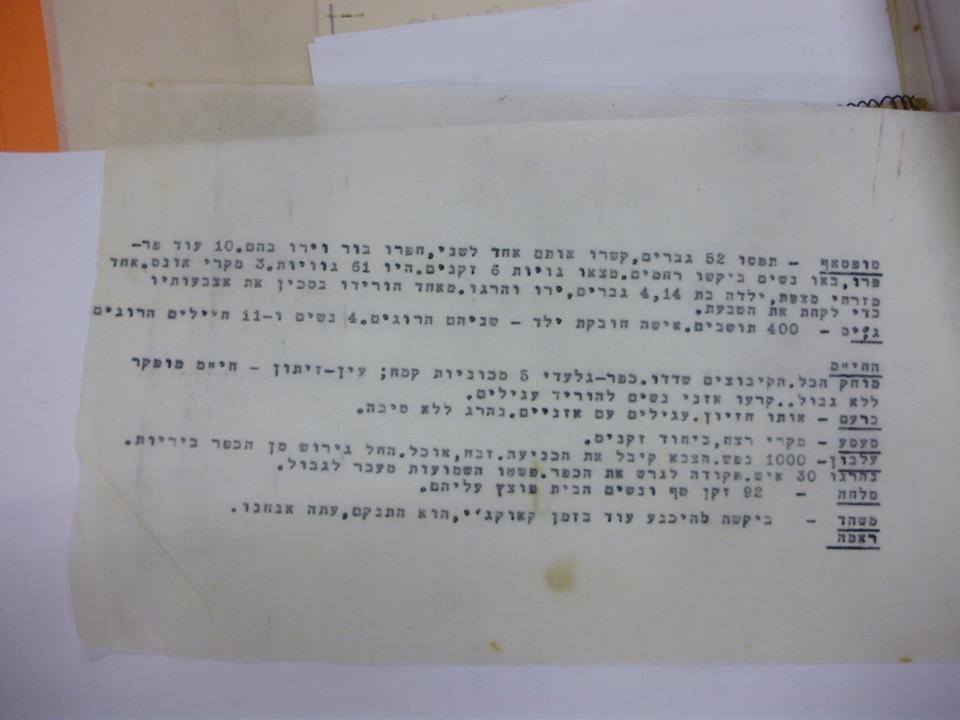Ilan Pappe, 20 June 2019. As per his original post on Facebook, text follows image.

I attach another document as part of our joint campaign to save the documents that probably will be inaccessible and lost in the future.
This is taken from Yossef Vashitz’s archive. Yossef Vashitz was a member of left-wing Zionist movement, ‘Hashomer Hazair’, whose members joined the PALMACH, the storm groups of the Hagana. In his private collection, there is half page, no date, but refers mainly to “operation Hiram”, 90 hours in which the Israeli army occupied the Upper Galilee at the very end of October 1948 (also one village in West Jerusalem is mentioned here).
Even this half a page is indicative of the brutality of the 1948 ethnic cleansing
and should be seen in conjunction of the other documents I have posted:
Here is the translation:
“Safsaf – [a village in the upper Galilee occupied in the Hiram operation]. They caught 52 men, tied them one to the other, dug a whole and shot them. Ten were still alive [then thrown into the pit] the women came and asked for mercy”.
They found [in Safsaf] bodies of six old men, all in all 61 bodies, three cases of rape (one Mizrahi [Jew rapist] from Safad, a child aged 14 [raped] four men shot and killed. They cut someone’s finger in order to remove his ring.
[Vashitz here quotes directly comments written down by a colleague of his in Mapam – the political party representing this ideological Kibbutz movement, Hashomer Hazair – Aharon Cohen (who later would be indicted for espionage for the USSR) during a meeting with one of the members of the Zionist cabal that planned and executed the ethnic cleansing (Ben-Gurion’s ‘advisory council), Israel Galili. And the full quote appeared in several sources including Benny Morris’ book.
Another quote about the massacre in Safsaf that appears in several books is taken from the Yossef Nahmani’s Diaries. Yossef Nahmani was a director in the JNF who purchased land for the Zionist project. His diaries revealed a list of atrocities committed in the end of October 1948 during the Hiram operation. On Safsaf he wrote: ‘In Safsf, after the soldiers entered the village, its people raised the white flag. They collected the men. Gathered the women and men separately. They tied the hands of 56 villagers and shot them, killed them and buried them in one hole. They also raped few of the women in the village. Near the woods, he (a soldier called Friedman) saw few dead women among them, one holding a dead child in her arms.]
Back to Vashitz’s document:
Jish: 400 inhabitants, a woman carrying a baby, both dead, four women (dead), 11 dead troops.
[al-Jish was a village in the Safad District. It was only village spared in an operation Hiram. A Polish Jews by the name of Moshe Zalinzki, decided to go even further then the ethnic cleansing orders he received and ordered, as a commander of chief in that area, to destroy completely the villages of Nabi Rubin, Tarbiha, Suruh, al-Mansura, Iqrit and Bir’iam. Some of these villages had a Maronite population in them and therefore the high command had not as yet decided whether to include them in the ethnic cleansing operation, but eventually did not stop the enthusiastic, kibbutznik to commit his particular version of war crimes].
Ein Zeitun –[a village in the Safad area inspired Eilas Khoury’s novel Bab al-Shams] they ripped the women’s ears in order to take their earrings.
Bir’im: the same scene. Earrings with ears; killed without reason.
Sasa: [a village in the upper Galilee destroyed in the Hiram operation] cases of murder, especially of old people.
Ilabun:
[A village in the lower Galilee, the Tabaria district, occupied in October 1948
during the Hiram operation]
1000 people, the army received the surrender, massacre, food. The expulsion of the village by shooting began. Thirty people were killed. An order to expel the village. The rumors have reached beyond the border. [under pressure from the international community they many were allowed to return].
Malha – [probably the village in West Jerusalem occupied in July 1948]: 92 old men, babies and women, the house was blown over them.
Mashad [a village near Nazareth; left intact] – wanted to surrender in the time of Qawqji [Fawzi al-Qawqji, the commander of the Arab Liberation Army of volunteers that came to help the Palestinians] he revenged, now we did. “
While is some sources, some of these atrocities are mentioned, they are always mentioned as war crimes committed in the heat of war. As the documents I have shown before indicate clearly, these actions were the rule and not the exception as means of ethnically cleansing Palestine.
Ilan Pappe is the author of numerous books, Ilan Pappe is professor of history and director of the European Centre for Palestine Studies at the University of Exeter. Find his titles in the IHRC Bookshop & Gallery.





